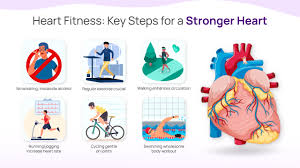Discover the essential fitness fundamentals that will help you build a strong and healthy lifestyle. Learn how exercise, nutrition, and mental well-being contribute to overall health and longevity.
Maintaining a fit and healthy lifestyle is more than just a trend; it is a lifelong commitment to physical, mental, and emotional well-being. Many people struggle with understanding the key components of fitness, often leading to inconsistent habits and ineffective workouts. In this guide, we will break down the fundamental principles of fitness, explaining how exercise, nutrition, and recovery contribute to a balanced and healthy life.
1. Understanding Fitness: What Does It Mean?
Fitness is a broad term that encompasses various aspects of health and well-being. It includes:
- Cardiovascular endurance – The ability of the heart and lungs to supply oxygen to the body during sustained physical activity.
- Muscular strength – The maximum force a muscle or group of muscles can exert.
- Muscular endurance – The ability of muscles to perform repeated contractions over time without fatigue.
- Flexibility – The range of motion available at a joint.
- Body composition – The proportion of fat, muscle, and other tissues in the body.
Balancing these components is crucial for overall fitness and long-term health.
2. The Importance of Exercise in a Healthy Lifestyle
2.1 Strength Training
Strength training is essential for building muscle mass, increasing metabolism, and improving bone density. Some popular strength training exercises include:
- Weightlifting
- Bodyweight exercises (push-ups, squats, lunges)
- Resistance band workouts
2.2 Cardiovascular Exercise
Cardio exercises improve heart health, burn calories, and increase endurance. Examples include:
- Running or jogging
- Cycling
- Swimming
- Jump rope
2.3 Flexibility and Mobility
Stretching and mobility exercises help prevent injuries, improve posture, and enhance overall movement. Effective flexibility training includes:
- Yoga
- Pilates
- Dynamic stretching
3. Nutrition: Fueling Your Fitness Journey
A well-balanced diet is crucial for sustaining energy levels and promoting muscle recovery. Key nutritional principles include:
3.1 Macronutrients
- Proteins – Essential for muscle repair and growth (e.g., lean meats, eggs, beans, tofu).
- Carbohydrates – The primary energy source (e.g., whole grains, fruits, vegetables).
- Fats – Important for hormone production and cell function (e.g., avocados, nuts, olive oil).
3.2 Micronutrients
- Vitamins and minerals support immune function, bone health, and overall well-being.
- Hydration is crucial for digestion, circulation, and temperature regulation.
3.3 Meal Timing and Portions
- Eating smaller, balanced meals throughout the day helps maintain energy levels.
- Post-workout nutrition should include protein and carbohydrates to support recovery.
4. The Role of Mental Health in Fitness
4.1 Stress Management
Chronic stress can lead to weight gain, sleep disturbances, and decreased motivation. Strategies to manage stress include:
- Meditation
- Deep breathing exercises
- Journaling
4.2 The Importance of Sleep
Sleep is essential for muscle recovery, mental clarity, and overall health. Adults should aim for 7-9 hours of quality sleep per night.
4.3 Building a Positive Mindset
- Set realistic fitness goals.
- Track progress to stay motivated.
- Find a supportive community or workout partner.
5. Recovery and Injury Prevention
Recovery is just as important as exercise. Some essential recovery techniques include:
5.1 Rest Days
- Schedule at least one or two rest days per week to allow muscles to recover.
5.2 Active Recovery
- Light activities such as walking, yoga, or stretching can promote blood circulation and reduce soreness.
5.3 Injury Prevention
- Warm up before workouts.
- Use proper form and technique.
- Listen to your body to avoid overtraining.
6. Creating a Sustainable Fitness Routine
6.1 Setting SMART Goals
- Specific – Define clear fitness objectives.
- Measurable – Track progress with tangible markers.
- Achievable – Set realistic targets.
- Relevant – Align goals with personal interests.
- Time-bound – Set deadlines to stay motivated.
6.2 Staying Consistent
- Find activities you enjoy.
- Schedule workouts at the same time each day.
- Celebrate small achievements to maintain motivation.
6.3 Adapting to Challenges
- Adjust workouts to fit your lifestyle.
- Stay flexible and open to change.
- Keep learning and evolving with new fitness trends.
Fitness is a lifelong journey that requires dedication, balance, and consistency. By understanding the fundamentals—exercise, nutrition, mental well-being, and recovery—you can create a sustainable and enjoyable fitness routine. The key is to stay consistent, listen to your body, and find what works best for you.
FAQ: Frequently Asked Questions
1. How often should I exercise?
It is recommended to exercise at least 150 minutes of moderate-intensity or 75 minutes of high-intensity activity per week, combined with strength training twice a week.
2. What is the best diet for fitness?
A balanced diet with lean proteins, complex carbohydrates, healthy fats, vitamins, and minerals is best for supporting an active lifestyle.
3. How can I stay motivated to work out?
Setting clear goals, tracking progress, and finding an enjoyable fitness routine can help maintain motivation.
4. Do I need to take supplements for fitness?
While whole foods should be the primary source of nutrients, some people benefit from supplements like protein powder, vitamins, or omega-3s, depending on individual needs.
5. How important is rest for fitness?
Rest and recovery are crucial for preventing injuries, allowing muscle repair, and maintaining long-term progress.
By incorporating these fitness fundamentals into your daily routine, you can achieve a healthier and stronger lifestyle. Stay committed, be patient, and enjoy the process!